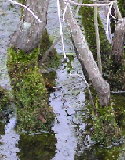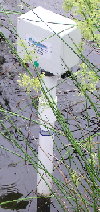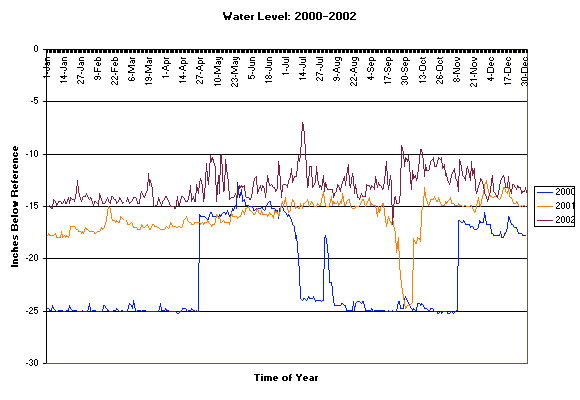|
|
|||||||||||||||||||||||||||||||||||||||||||||||||||
|
|||||||||||||||||||||||||||||||||||||||||||||||||||
| Wetland Indicators | |||||||||||||||||||||||||||||||||||||||||||||||||||
| Apart from the type of vegetation, there are other characteristic indicators of wetlands which can easily be seen. | |||||||||||||||||||||||||||||||||||||||||||||||||||
| Moss on tree trunks | |||||||||||||||||||||||||||||||||||||||||||||||||||
| Moss line on tree bark: If trees are standing in water for any length of time, moss will grow on the bark. Usually mosses and lichens grow above the highest water level, while aquatic mosses and liverworts grow at a lower level which is more frequently saturated. Iron film on water surface: This occurs in enduring pools of water. Much of the color in soil comes from iron in the oxidized form, Fe3+. In water-saturated soil there is little oxygen (anaerobic conditions), and this iron becomes reduced to the Fe2+ form. The reduced form has little color, so hydric or water-saturated soil has a gray color. Fe2+ is much more soluble than the oxidized form and is therefore available to living organisms. Chemosynthetic bacteria convert the iron back to its oxidized form and this, being less soluble, forms a film of precipitate on the water surface which looks somewhat like an oil-slick to the casual observer. Local regions of oxidation of iron in hydric soil can also produce orange-brown streaks where rootlets have released oxygen. |
|||||||||||||||||||||||||||||||||||||||||||||||||||
 |
|||||||||||||||||||||||||||||||||||||||||||||||||||
| Floating iron | |||||||||||||||||||||||||||||||||||||||||||||||||||
 |
|||||||||||||||||||||||||||||||||||||||||||||||||||
| Click on photos to enlarge | |||||||||||||||||||||||||||||||||||||||||||||||||||


